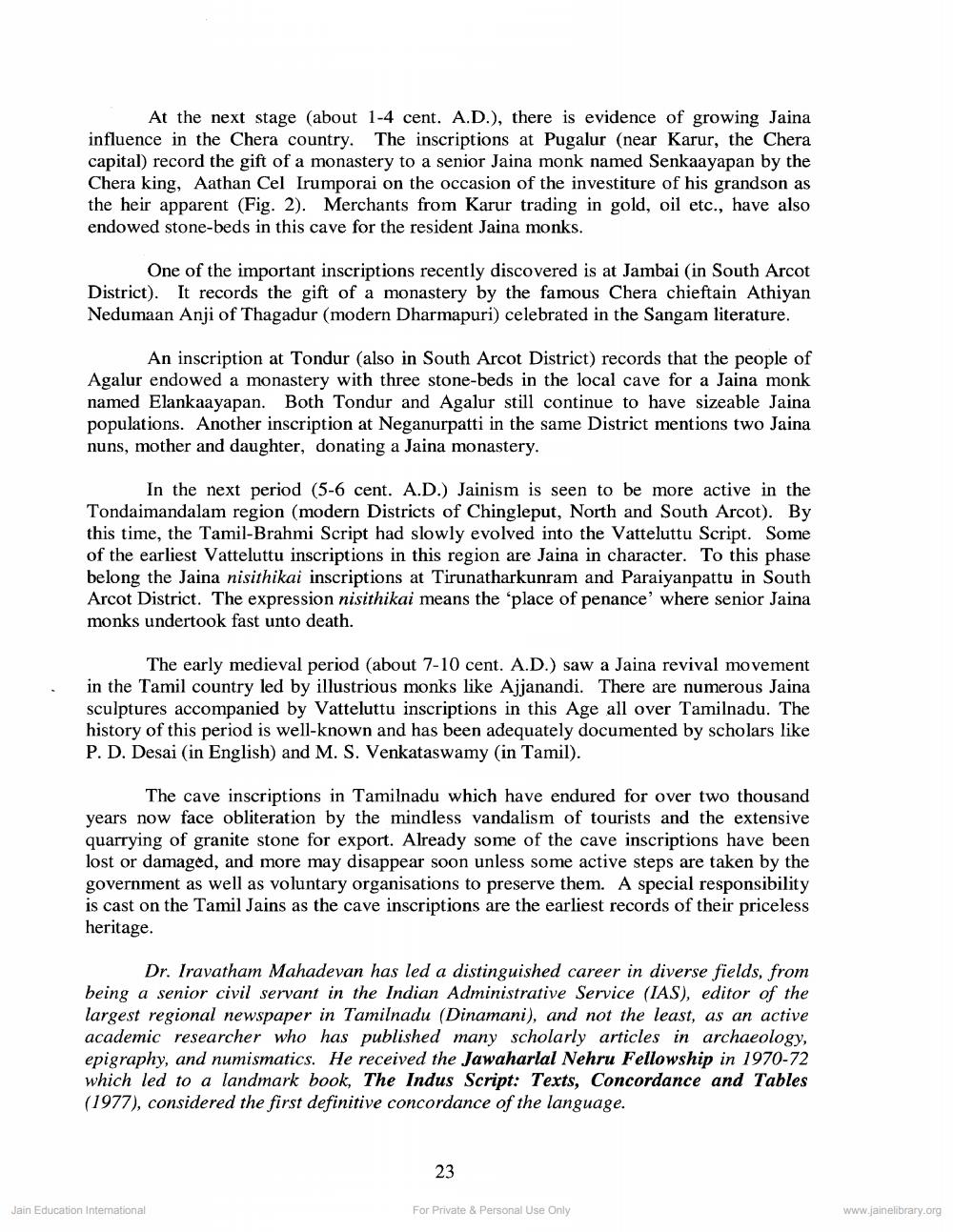________________
At the next stage (about 1-4 cent. A.D.), there is evidence of growing Jaina influence in the Chera country. The inscriptions at Pugalur (near Karur, the Chera capital) record the gift of a monastery to a senior Jaina monk named Senkaayapan by the Chera king, Aathan Cel Irumporai on the occasion of the investiture of his grandson as the heir apparent (Fig. 2). Merchants from Karur trading in gold, oil etc., have also endowed stone-beds in this cave for the resident Jaina monks.
One of the important inscriptions recently discovered is at Jambai (in South Arcot District). It records the gift of a monastery by the famous Chera chieftain Athiyan Nedumaan Anji of Thagadur (modern Dharmapuri) celebrated in the Sangam literature.
An inscription at Tondur (also in South Arcot District) records that the people of Agalur endowed a monastery with three stone-beds in the local cave for a Jaina monk named Elankaayapan. Both Tondur and Agalur still continue to have sizeable Jaina populations. Another inscription at Neganurpatti in the same District mentions two Jaina nuns, mother and daughter, donating a Jaina monastery.
In the next period (5-6 cent. A.D.) Jainism is seen to be more active in the Tondaimandalam region (modern Districts of Chingleput, North and South Arcot). By this time, the Tamil-Brahmi Script had slowly evolved into the Vatteluttu Script. Some of the earliest Vatteluttu inscriptions in this region are Jaina in character. To this phase belong the Jaina nisithikai inscriptions at Tirunatharkunram and Paraiyanpattu in South Arcot District. The expression nisithikai means the 'place of penance' where senior Jaina monks undertook fast unto death.
The early medieval period (about 7-10 cent. A.D.) saw a Jaina revival movement in the Tamil country led by illustrious monks like Ajjanandi. There are numerous Jaina sculptures accompanied by Vatteluttu inscriptions in this Age all over Tamilnadu. The history of this period is well-known and has been adequately documented by scholars like P. D. Desai (in English) and M. S. Venkataswamy (in Tamil).
The cave inscriptions in Tamilnadu which have endured for over two thousand years now face obliteration by the mindless vandalism of tourists and the extensive quarrying of granite stone for export. Already some of the cave inscriptions have been lost or damaged, and more may disappear soon unless some active steps are taken by the government as well as voluntary organisations to preserve them. A special responsibility is cast on the Tamil Jains as the cave inscriptions are the earliest records of their priceless heritage.
Dr. Iravatham Mahadevan has led a distinguished career in diverse fields, from being a senior civil servant in the Indian Administrative Service (IAS), editor of the largest regional newspaper in Tamilnadu (Dinamani), and not the least, as an active academic researcher who has published many scholarly articles in archaeology, epigraphy, and numismatics. He received the Jawaharlal Nehru Fellowship in 1970-72 which led to a landmark book, The Indus Script: Texts, Concordance and Tables (1977), considered the first definitive concordance of the language.
Jain Education International
23
For Private & Personal Use Only
www.jainelibrary.org




